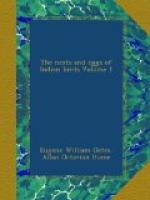Colonel E.A. Butler records the following notes:—“The Black-headed Myna breeds plentifully in the neighbourhood of Deesa in June, July, and August, but somehow or other I was unlucky this year (1876) in procuring eggs. On the 30th July I found a nest containing four young birds and another containing four eggs about to hatch. On the 2nd of August I found three nests, all containing young birds. On the 20th August I found four more nests; three contained young birds and the fourth four fresh eggs. All of these nests were in holes of trees, in most instances only just large enough at the entrance for the bird to pass through. In some cases there was no lining at all except wood dust, in others a small quantity of dry grass and a few feathers. The average height from the ground was about 8 or 10 feet; some nests were, however, not more than 4 or 5 feet high.
“Belgaum, 21st May, 1879.—A nest in the roof of a house under the tiles; three fresh eggs. Another nest on the same date in a hole of a tree, containing one fresh egg. The hole appeared to be an old nest-hole of a Barbet. Other nests observed later on, in June and July, in the roofs of houses under the tiles. Another nest in the hole of a tree, 27th April, containing four fresh eggs. Three more nests, 4th May, containing three incubated eggs, three fresh eggs, and three young birds respectively. Two of the nests were in the nest-holes of Barbets, from which I had taken eggs the month previous. 7th May, another nest containing four fresh eggs.
“I can confirm Dr. Jerdon’s statement, quoted in the Rough Draft of ‘Nests and Eggs of Indian Birds,’ relative to this species breeding in large buildings, having observed several nests myself this season at Belgaum on the roofs of bungalows. In one bungalow, the mess-house of the 83rd Regt., there were no less than three nests at one time built under the eaves of the roof.”
Messrs. Davidson and Wenden, writing of the Deccan, say:—“Not quite so common as Acridotheres tristis. Breeds at Satara in May.”
Mr. Benjamin Aitken remarks:—“In Nests and Eggs, p. 433, you write:—’Dr. Jerdon says that at Madras it breeds about large buildings, pagodas, houses, &c.’ This is doubtless correct, but has not been confirmed as yet by any of my Southern Indian correspondents, who all talk of finding its nest in holes of trees.’ On the 29th June last year I was at the Anniversary Meeting of the Medical College, and the proceedings were disturbed by the incessant clatter of two broods of young of this species. The nests were in holes in the wall near the roof, and the two pairs of old birds, which were feeding their young, kept coming and going the whole time, flying in at the windows and popping into the holes over the peoples’ heads. In the following month a nest of young were taken out of a hole in the outer wall of a house I was staying at, and the birds laid again and hatched another brood.




